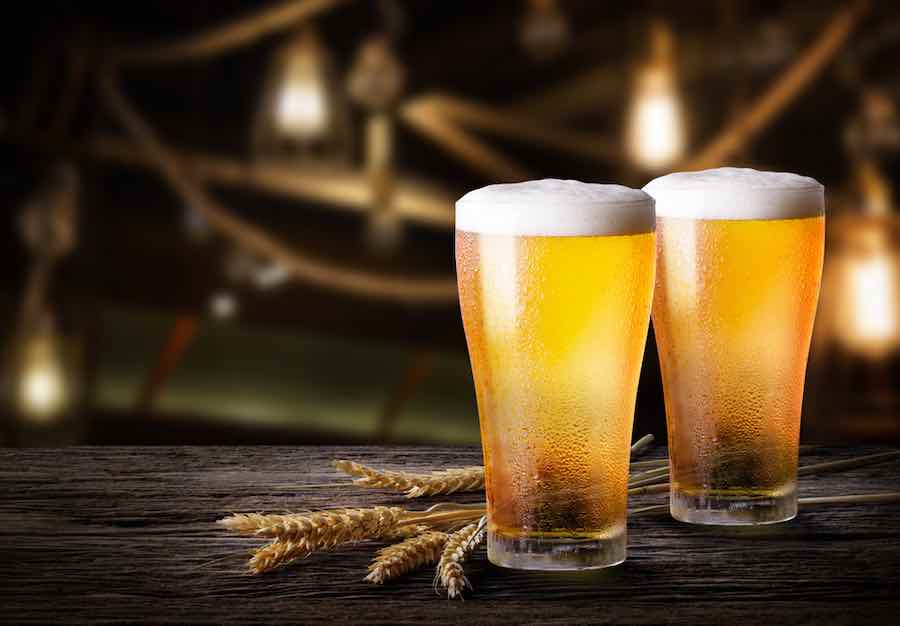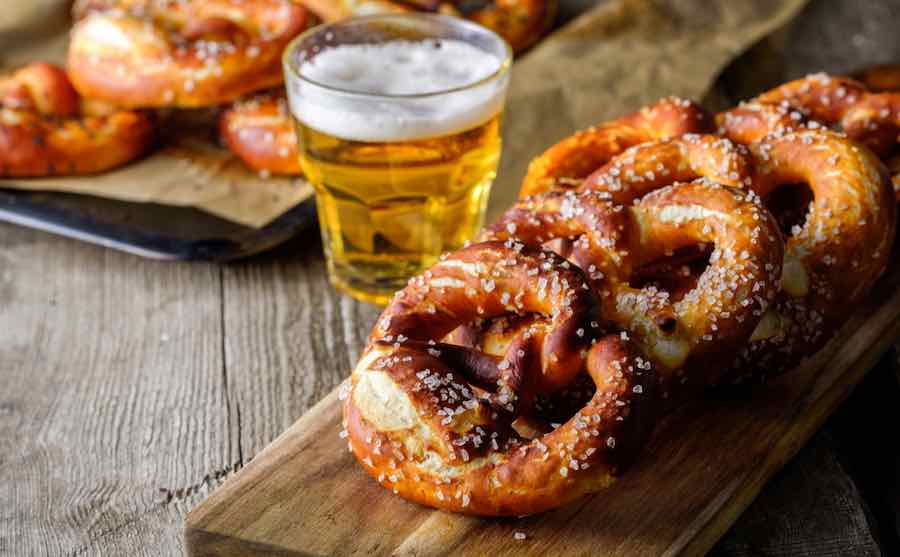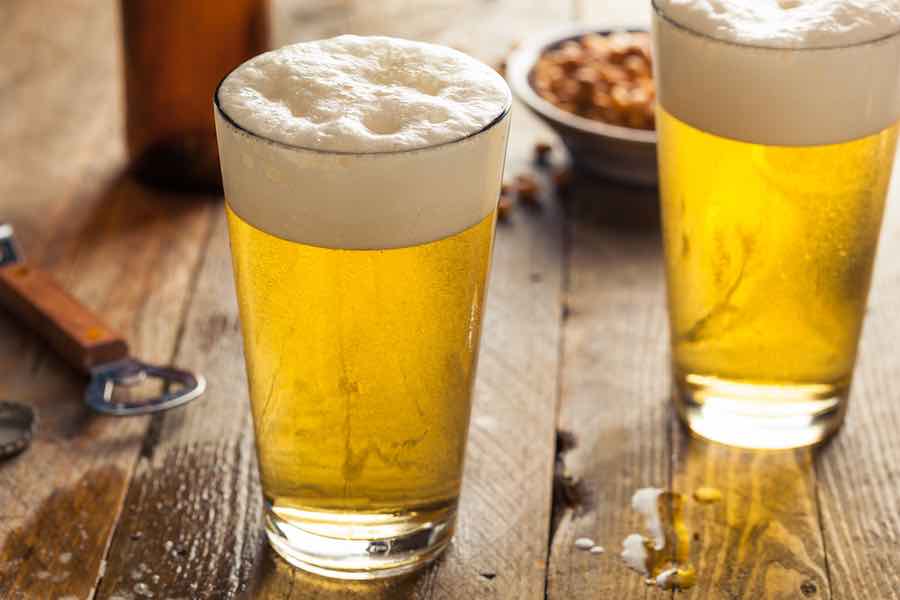American Lager beer, also known as North American Lager, was born out of an original brewing process for another light beer, the Pilsner. Perfect for any event, any time of day, or any season throughout the year, American lagers are a staple in the US and many other locations as far as beers are concerned.
There’s nothing that flows quite as easy as a cold American-style light lager, which makes it appealing to almost any crowd. Despite its simple taste, unremarkable blend of ingredients and reputation of being a watered-down version of a “real beer”, there is no denying its appeal and widespread popularity since German immigrants graced the United States soil with their lager recipe in the mid-19th century.
The Birth of American Lager Beer
Until the mid-1800s, most of the beer in the United States was much stronger and much darker than the most popular beers today. The Temperance movement actually helped the rise in popularity of beer because it was seen as somewhat of a lesser of two evils compared with hard liquor, which was seen as the main focus of the movement.
In conjunction, boatloads of German immigrants were arriving in America seeking political and religious freedom along with new opportunities. They brought along their brewing expertise to re-create their beloved beers in the United States.
The differences in the brewing at that time had little to do with brewers’ preference and entirely to do with location. Unfortunately, the climate difference and lack of availability of things like barley made brewing beer in North America much more difficult.
For hundreds of years, cold fermenting with lager yeast has been regular brewing practice in Germany where the climate is much more cold and wet. In the United States, until refrigeration systems were used to mimic this “lagering” process, lagers were typically much darker and a bit smokier than the lagers we are accustomed to drinking today.
Lighter Lagers
German brewers were trying to replicate the golden-brown lagers they were used to in their homeland once migrating to the United States, but had to make do with what was available and affordable at the time.
Because of this, corn and rice were heavily used in the brewing process as a result of their abundance and availability in the United States. Significant quantities of grains replaced the barley malt and the corn gave a sweeter, lighter, straw colored crisp beer. This beer was now known as American lager beer.
These light lagers were a huge hit, especially among the working class. The ideal was that the lighter colored and lighter tasting beers had less alcohol content, making it a perfect beverage for their lunch break that they could drink with ease. However, this newfound liquid freedom would not be so carefree for long.

The Impacts of Prohibition & The Great Depression
Soon, with the passing of the 18th Amendment in 1920 also came the start of Prohibition. Breweries and pubs took a massive hit throughout this time, with only a handful even being able to keep their doors open. For 13 long years, brewing beer was nonexistent and extremely risky if done illegally.
In 1933 when Prohibition was repealed, everyone was dying for a sip of their beloved bland lagers and by popular demand, they came flowing back in. Some breweries were able to open back up their equipment and get to brewing right away, while other breweries lacked the financial means to open their doors again.
There were also some breweries that took a huge hit during the Great Depression and consolidated with other breweries as an attempt to stay afloat. Wartime grain restrictions reinforced the use of rice and corn as it was before and slowly but surely, America’s favorite beer was back in full force. Welcome back American lager!
The Legalization of Home Brewing
After the beer industry took a huge blow during the prohibition, light lagers were some of the only beers available until home brewing was legalized by President Jimmy Carter in 1978.
Amongst the tidal wave of microbreweries that have swept the nation over the last 40 years, some of the most popular and widely bought beers are still American lagers, such as Budweiser, Coors Light, Miller Lite, Miller Genuine Draft, etc.
Even most craft breweries have their own versions of American lagers because of the undeniable popularity nationwide as well as the simplicity and drinkability.
Brewing America’s Favorite Beer
American lager is a pale lager-style beer. The look and taste may be simple, but when you are looking for something reliable and easy to drink, you really can’t go wrong here.
If you’ve read our previous article, American Light Lagers Explained: A Brief History, you probably already know that the original German ingredients for American lagers, mainly the grains, were replaced by things like corn and rice.
Combining a refrigeration process called lagering during fermentation, American light lagers were a masterpiece from the start. This created a much lighter and cheaper beer than the original German recipe, and has remained that way ever since.
Prior to the Prohibition, light lagers were primarily brewed with 4 ingredients; pale malts, flaked maize, domestic hops and imported hops. The brewing process started like any other, the mashing procedure and then sparging before boiling, followed by fermentation.
The changes really came in the lagering process and the ingredients. The United States barley was much more expensive than in Germany and the texture was much different as well. It was much higher in protein, which made it have somewhat of a gummy feel to it when it was broken down, making it much harder to use for brewing.
This is where the idea to use other grains that were much lower in protein, like rice and corn came from. These grains gave a much closer comparison to the lagers made in Germany that they were so desperately trying to replicate.
Lagers are generally lighter and have less calories than other beers. The average ABV is between 2.5% and 5% with extremely mild malts, hops and aroma. The flavor is very crisp and dry but does have a hint of sweetness from the corn and rice. It is known for its thirst-quenching abilities, as well as its refreshing taste. They tend to be highly carbonated, which could have an added bite at the end.
Variations Over Time
Today, lagers have a couple different types that you generally see in the market. The three most popular are light lagers, standard lagers and premium lagers. Like everything else in the United States, we tend to do things to excess and have different variations of everything we do to appeal to as many people as possible, so this should come as no surprise!
Light lagers are generally the most refreshing of the three with typically a 2.5% ABV, about 40% adjuncts in the malt and just enough hops for a balance. Some of the most popular examples are Miller Lite, Bud Light, Bud Select, Coors Light, and Michelob Ultra. Light lagers are honestly not much different than the standard lagers which are next in line.
They also use about 40% adjuncts and have almost the same exact ingredients as the light lagers, but in higher quantities. The color tends to be more of a golden yellow than the pale straw color of the light lagers and have more distinctive flavors, depending on the ingredients used. Some of the most popular standard lagers are Miller High Life, Budweiser, Coors Banquet and Pabst Blue Ribbon.
The last category of lagers is called premium lagers. This has much fewer adjunct properties at only about 25% and tends to have a much higher aroma and hop presence with a slightly more distinctive flavor than the previous two versions. Some of the most popular premium lagers are Stella Artois, Heineken, Corona, and Miller Genuine Draft.
The Rise of Craft Beer
How many times have you sat down at a brew pub or craft beer bar with a beer list as long as your arm, front and back, with so many different options it took longer to choose than to actually drink the pint? (Thank God for beer flights!)
Trying different types and styles of beers has become a regular hobby for so many people, and for some it is even more of a passion and expertise. Traveling to different breweries and trying as many beers as possible could be anyone’s weekend dream.
However, there is also a flip side. What about another common weekend dream of going to a sporting event early in the morning and tailgating before and/or after the game, going to a concert to see your favorite band and tailgating in the parking lot, all day barbeques with friends and family, or even just spending time with friends around the pool or a cozy fire with a healthy stash of smooth and light American lager on ice.
American lagers are known for their light bodies, relatively low ABV’s and smooth taste, making it the perfect choice for all your favorite marathon drinking events. There is nothing complex about light lagers, but sometimes there’s beauty in simplicity. They don’t call it America’s favorite beer for nothing!
It is so easy for beer snobs to wince at the sight of an American lager beer, but given American lagers are still the most popular beer in the country, it may not be warranted. It may be for the consistency and reliability, it may be for how easy they are to drink, or it may be simply because everyone’s sure to be able to drink it if you’re buying for a crowd.
Regardless of the reason, there’s no denying its popularity and status in the beer industry.

What American Lagers Represent
American lagers are crystal clear golden yellow to pale straw in color with a with and foamy head. The aroma is barely there but could have a hint of grainy malt or sweet corn, depending on the ingredients and brewing. The hops are very slight, but you may be able to find a hint of spices or floral notes. The mouthfeel is very light, but highly carbonated. Some may say the taste is even a bit watery, but generally it’s pretty neutral when it comes to tasting the flavor of this beer. All of the ingredients are pretty balanced, which makes the taste of malt and hops balanced as well.
When pairing with food, it usually compliments lighter foods the best like lightly grilled fish, salads, fish tacos, pizza, marinated chicken, etc. Because of the high level of carbonation, it tends to keep the palate fresh and could hold its own against a little heat as well.
Snack foods are also a great comparison, especially if they have a lot of salt like pretzels, popcorn, chips, etc. That also means it would pair well with spicier fresh cheeses.
Simplicity at Its Finest
Simplicity can be seen as the biggest strength or the biggest weakness of traditional American lager beer. Some avid craft beer drinkers refuse to stoop to the level of consuming these watered-down beers, but there’s other times it’s the perfect companion.
Because of the light and extremely mild notes of American lagers, they are easy to pair with most foods and are easy to please most crowds. They could be particularly refreshing when paired with different meats and cheeses, as well as fruits and salads, which provides much more diversity than your typical craft beer or homebrew.
They could also be the perfect start to your own homebrewing journey, because of the ease of the recipe and minimal ingredients. If you are interested in getting into homebrewing and aren’t sure where to start, a wonderful resource is 10 Easy Home Brewing Recipes Perfect For Beginners.
If you already have the basics to the homebrewing process down and you’re looking to brush up on the different recipes that can give your homebrews the perfect flavor, techniques or combination, you should definitely check out Off Flavors In Brewing or Mashing: Alphas and Betas.
And if you’re the kind of person who doesn’t care too much about the small details or conjuring up the perfect homebrew and you just want to make it already so you could drink it, don’t worry, we have suggestions for you too! Check out Lazy Homebrewing – Making Beer As Cheap & Easy As Possible.
Try Some of The Best & Most Popular Brands
Looking for some of the most popular American lagers to try? I bet you will find some on this list you’ve already had, but hopefully there’s a few you haven’t so you can give them a try as well!
- #Merica! – Surly Brewing Company
- 1811 Lager – Fort George Brewing Company
- Budweiser – Anheuser-Busch
- Busch – Anheuser-Busch
- Coors Banquet – Molson Coors Brewing Company
- Lager – Guns & Oil Brewing Company
- Luchesa Lager – Oasis Texas Brewing Company
- Michelob Ultra – Anheuser-Busch
- Miller High Life – Molson Coors Brewing Company
- Milwaukee’s Best – Molson Coors Brewing Company
- Narragansett Lager – Narragansett Brewing Company
- Natural Ice – Anheuser-Busch
- Pabst Blue Ribbon – Pabst Brewing Company
- Schlitz Gusto – Schlitz Brewing Company
- Stella Artois – Anheuser-Busch
- The Crisp – Sixpoint Brewing
- Two Women – New Glarus Brewing Company
- Yuengling Traditional Lager – Yuengling Brewing Company

